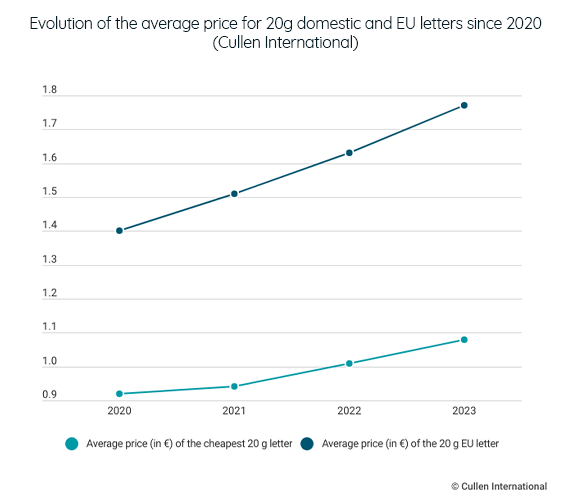Cullen International’s latest research shows that postal universal service providers throughout Europe are raising the prices of their letters services. The letters segment has been under particular pressure in recent years due to rapidly falling volumes. Decreasing levels of profitability, and higher operational costs and inflation rates may all be factors behind the price rises.
Cullen International’s national benchmark on the prices of letters and packets shows that the prices of 20 g letter services have risen in the past year in every country monitored except France and Germany.

Across the monitored countries, the average price for the cheapest 20 g letter service rose from €0.92 in June 2020 to €1.08 in March 2023, a 17% rise. The price rise was not limited to domestic letters: the average price of intra-EU 20 g letters increased by 26% in the same period to reach €1.77.
There is significant pricing variation between countries. The most expensive 20 g domestic letter service is offered in Finland at €2.10, followed by Norway at €1.93. The cheapest service is offered in Portugal for €0.61.
Cullen International’s Postal service provides comprehensive national benchmarks comparing both letter and parcel pricing. In addition, the service provides benchmarks and reports on the different approaches by national authorities on regulating retail prices.
For more information and to access the benchmark, please click on “Access the full content” - or on “Request Access”, in case you are not subscribed to our European Postal intelligence.
more news
11 September 25
EU initiatives to foster satellite connectivity
Our new Tracker covers the Commission’s flagship initiatives in relation to satellite infrastructure, satellite spectrum and new converged services like direct-to-device (D2D). It also covers the EU’s preparations for the World Radiocommunication Conference 2027 (WRC-27), where satellite is on the agenda.
11 September 25
[INFOGRAPHIC] Top 10 European antitrust fines on Big Tech
The European Commission’s €2.95bn fine against Google is the latest in a string of hefty antitrust penalties that competition authorities in Europe have imposed on US Big Tech firms. Cullen International’s infographic provides an overview of these fines, putting them in context and showing how they are calculated.
10 September 25
Transposition status of key EU environmental directives
Our new benchmark contains summary information on the transposition status of six key EU environmental directives.